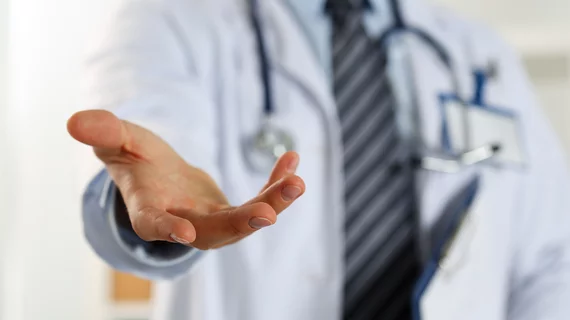‘Concerning’ data connect industry payments to cardiologists with medical device use
Cardiologists who receive industry payments from Abiomed are more than twice as likely to use the company’s intravascular microaxial left ventricular assist devices (LVADs), according to a new analysis published in JAMA.[1]
The payments were often modest, researchers noted, but they still found the connection to be “concerning.”
“Mechanical circulatory support devices are increasingly used by physicians for patients receiving percutaneous coronary intervention (PCI),” explained first author Sanket S. Dhruva, MD, MHS, an assistant professor of medicine with the University of California San Francisco School of Medicine, and colleagues. “Use of intra-aortic balloon pumps (IABPs) has decreased, whereas use of intravascular microaxial LVADs grew from 4.1% to 9.8% of all PCIs for acute myocardial infarction complicated by cardiogenic shock from 2015 to 2017 despite limited evidence demonstrating safety or clinical effectiveness and higher cost. Payments—even relatively small payments—from industry to physicians have been associated with greater likelihood of brand-name drug prescribing and medical device use. We examined whether payments from the LVAD manufacturer to cardiologists performing PCI were associated with any use of LVADs.”
Dhruva et al. examined open payments data for more than 6,000 interventional cardiologists who performed PCI for Medicare patients from 2016 to 2018. The median cardiologist age was 52 years old, and nearly 96% were men. While 59.3% of cardiologists placed at least one mechanical circulatory support device during that time, 29.2% placed at least one LVAD.
A total of 56% of the cardiologists included in this study reported receiving an industry payment from Abiomed, the only company currently manufacturing intravascular microaxial LVADs. The median payment value was just $164. Payments that were specifically for research or royalties were not included in the team’s analysis; all other payments were included.
How did payments impact microaxial LVAD use? Overall, 23.2% of cardiologists who received an industry payment from Abiomed used at least one microaxial LVAD on a patient. Among cardiologists who never received any sort of industry payment from Abiomed, that number was 9.5%.
In addition, cardiologists who received industry payments from Abiomed were more likely to use a percutaneous microaxial LVAD in the year of payment or in the subsequent year. The odds increased the most when the payment was especially high.
“Intravascular microaxial LVAD manufacturer payments (often modest) to cardiologists were associated with increased use of LVADs by cardiologists who perform PCIs,” the authors concluded. “It is concerning that payments from the manufacturer to cardiologists may be associated with increased use of more expensive medical devices not demonstrated to be more safe or effective.”
Click here to read the full research letter about industry payments and microaxial LVAD use in JAMA.
Abiomed comments on new research
"Healthcare providers are uniquely qualified to provide peer-to-peer education and insights into the development and use of new treatments that improve patients’ lives," a company spokesperson told Cardiovacular Business. "Transparent and compliant interactions enable us to develop new products and help ensure they are being used as intended."
Industry payments are common in cardiology
To be clear: Medical device manufacturers and pharmaceutical companies regularly make payments to physicians. In fact, one recent study found that cardiologists received $1.29 billion in industry payments from 2013 to 2022, No. 3 among all healthcare specialties.
There is nothing legally questionable about any of the industry payments included in this analysis.
Researchers share additional context and perspective
Dhruva and his co-author Joseph S. Ross, MD, MHS, wrote a commentary detailing their research for MedPage Today. They examined the long history of safety concerns related to microaxial LVADs—including a recent recall of more than 66,000 Impella devices after 49 deaths—as well as the question of whether or not payments to physician should even be allowed.
“Physicians may not believe—or want to believe—that they are influenced by payments from industry,” the two co-authors wrote. “But payments clearly influence decision-making, both subtly through feelings of reciprocity and overtly through marketing and promotional materials. Should this be allowed? Or should the profession seek ways to mitigate the influence of industry in medicine?”
Read more from their commentary here.

